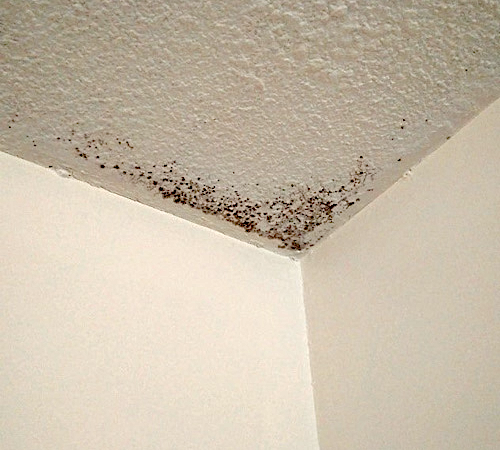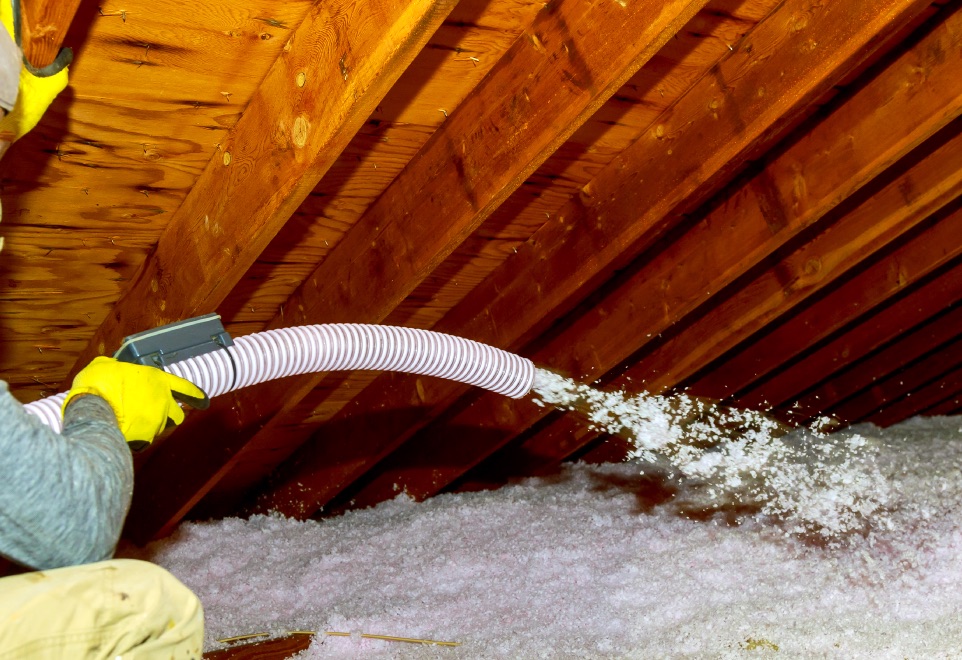What did we just notice? Mould in the Corner.
Well…winter is almost over and Spring is about to begin and we have just noticed mould in the corner of the master bedroom ceiling. We don’t believe that it was there yesterday. You are concerned because you don’t know why you would get mould on your mostly new home.
Mould is something that happens to older homes isn’t it?
Well, actually it is recent changes in the way insulation is being installed in attics that can be the culprit.The insulation I am talking is what most people are now getting in their attics; loose fill, whether it be fibreglass, rock wool, or cellulose based insulation. The risk has to do with the way this insulation is being installed in some cases.

Before we get into that, let’s look at what mould needs to grow:
- Moisture;
- A food source; and
- The right temperature for germination and growth.
The first one; moisture is the most important one. Like any other thing, mould requires water in order to survive and prosper. Water can take the form of liquid water as in a puddle or a fine film on a surface. It can also take the form of high humidity. If mould spores get water, the spores swell, burst and then put down roots and grow….into the 2nd requirement; a food source.
What About a Food Source?
Mould will “eat” any organic material, that is, one which contains carbon atoms. This organic material will supply the mould with enough energy to grow. Mould will grow rapidly given any source of food. Cellulose is a good food source, especially the paper backing on drywall. The paper-making process pre-digests the wood pulp. It is then easier for mould to break it down further.
Mould will also grow on leather, furs, cotton, linen, silk, wood, just about anything. Even dust will support mould growth. This is because dust is primarily of plant pollen, human and animal hairs, textile fibres, paper filers, minerals from outdoor soil, human skin cells, and many other materials. As such, even a seemingly clean surface could support mould growth. Think about the mould that you sometimes find at the bottom of your windows. I guarantee you it is surviving on dust which accumulates in this corners. So that brings us to the last criteria; temperature.
Ok, so it Must be Too Cold or Too Hot for Mould.
Mould thrives quite well from 32F (0C) to 120F (49C), but its activity is heightened between 70 and 90 F (21C to 32C). The temperatures in most homes are in the heightened mould growth range of temperatures. Let’s go back and look at the corner of that bedroom ceiling. What exactly happened there?
Well…normally there would not be enough moisture on the corner of the ceiling to allow mould to grow, even though the temperature at the top of the room would provide the heightened growth range temperatures.
What has happened though is that there is a very fine film of water there and the reason is out of our line of site. The average homeowner will never see it as it hides in the attic, and we know how people like going up into their attics.
Tell me About the Attic?
In these days of fast and efficient construction methods, often insulation installers miss that extra step to prevent mould. How can an insulation installer prevent mould you ask? Well….let’s see just how they do their job first then we can understand their impact on our health.
When the home is built there is a vapour barrier installed under the ceiling joists and then the drywall is installed. Once the rough-in wiring is completed and inspected the insulation can go in the home, including the attic, the exterior walls and the basement foundation above ground level.
Before blowing in loose fill insulation into the attic most installers will stuff fibreglass batts into the rafter cavities that won’t be provided with baffles to keep the loose fill insulation from going into the soffits. This is a critical step, and one where a simple mistake can cause a much bigger problem. We will get to that later in this post.
Once all the baffles and batts are in place the insulation installers will blow in the required depth of insulation according to the local building codes. The depth and R-Values get recorded on an insulation install certificate and they are done. For most home and for a while this is ok. Everything hums along just fine.

Well so Far I Don’t See a Problem. Tell me more
There are the odd houses that are susceptible to mould for a number of reasons. One is location and the other is prevailing wind direction. Building a house next to a undeveloped field, park, or open area, or a house that sits at the end of a street, makes it susceptible to wind gusts. This is especially true if the prevailing wind comes through the open area facing the home, whether it be the front, side or the back of the house.
Sometimes the wind gusts are just at the right angle and from the right direction to blow one or more of those stuffed in fibreglass batts to blow them away from the soffit area they protect. From there it is just a matter of time for the wind to gently blow the loose fill insulation away from that particular area (which happens to be the junction between the exterior wall and the ceiling, and mound the insulation up, away from the soffit area. This leaves a portion of the vapour covered drywall exposed.
Dew Point and Why it Matters
The outside surface of the drywall then is susceptible to the cold temperatures in the winter time. This dropping of temperature on the outside of the drywall translates to a cold spot on the inside of the drywall, the bedroom ceiling. A cold spot which is at or below the dew point of the ambient air in the room.
The dew point is the temperature at which the humidity in the air condenses. It is this condensation which allows the mould spores to germinate, develop, mature, re-seed, germinate, develop, mature, re-seed, and so forth.
You will take a while before noticing mould growth on your ceiling as it starts off being barely visible. Also the human mind being what it is, we get used to it until one day we look, and really see. Then, the question comes out “where did that come from?”.
So Now I Know What Happened
Well now you have a better idea of why you ended up with mould in the corner of your master bedroom (or other bedroom/bathroom, etc) ceiling. Your culprit was there before the home was occupied and has been hiding waiting for the right time to strike.But I Want to Know Why!
Oh by the way, the important step that was missed? They didn’t staple the batts in place to prevent the wind from blowing them away.
The Canadian Mortgage and Housing Corporation (CMHC) has some good information on home insulation.
If you wish some information or assistance with your attic mould problem, contact MouldMedic® today.